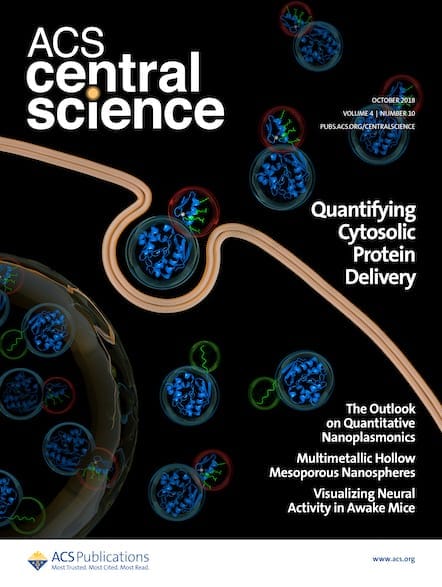When chemists want to make only one of a molecule’s two mirror-image enantiomers, they typically use chiral catalysts to steer their synthesis in the right direction. Now researchers have shown that chiral solvents can act as the sole source of handedness in several catalytic reactions that preferentially produce a single enantiomer. The process relies on […]

When chemists want to make only one of a molecule’s two mirror-image enantiomers, they typically use chiral catalysts to steer their synthesis in the right direction. Now researchers have shown that chiral solvents can act as the sole source of handedness in several catalytic reactions that preferentially produce a single enantiomer.
The process relies on a two-stage “chiral relay.” First, the chirality of the solvent is passed on to a polymer that can twist into a left- or right-handed helix. Then the helix binds a metal catalyst, creating a chiral structure that can control the symmetry of a reaction. In general, this strategy could offer a simpler route to making chiral metal catalysts, says Michinori Suginome of Kyoto University, who led the work.
The chiral relay depends on poly(quinoxaline-2,3-diyl) (PQX) molecules, which readily form rigid helices, and the researchers tested the ability of a range of PQXs to take on the chirality of various solvents. They got the best results from polymers containing about 1,000 quinoxaline units bearing n-propoxymethyl side chains, using (R)-limonene as the solvent.
Carrying out a Suzuki-Miyaura reaction with a poly(quinoxaline-2,3-diyl) copolymer and a palladium catalyst in a chiral solvent—(R)-limonene—made the S enantiomer of the product in 98% enantiomeric excess.
Even (R)-limonene with an enantiomeric excess of only 65%—a 5:1 ratio of right-handed limonene molecules to left-handed ones—was enough to produce exclusively right-handed helices. “What’s remarkable is that they don’t need to have the solvent in full enantiomeric purity,” says Walter Leitner of the Max Planck Institute for Chemical Energy Conversion.
The researchers then created a PQX copolymer in which roughly 10 of the 1,000 quinoxaline units carried a (diphenylphosphino)phenyl group. They let the PQX stand in (R)-limonene for 24 h at room temperature to form the required helix and then added a palladium compound that bound to the polymer’s phosphorus atoms to produce a chiral catalyst.
The team tested this catalyst in the Suzuki-Miyaura reaction, which forms a carbon-carbon bond by coupling an aryl bromide to an aryl boronic acid. It produced almost entirely one enantiomer of the coupling product, with an enantiomeric excess of 98% (a 99:1 mixture of enantiomers). The researchers also found that PQX-based chiral catalysts achieved high enantioselectivities in other reactions, including a hydrosilylation.
The team even isolated the helical PQX-palladium catalyst, dried it to remove any residual (R)-limonene, and used it to drive the asymmetric Suzuki-Miyaura coupling in tetrahydrofuran, an achiral solvent (albeit achieving a lower enantiomeric excess of 45–88%, depending on the solvent).
Some unusual chiral solvents have been used in enantioselective synthesis before, but they have typically offered only modest enantioselectivity. “This is the first example with extremely high enantiomeric excess,” says Bert W. Meijer at Eindhoven University of Technology. (R)-limonene is also an inexpensive source of chirality that can be extracted from orange peel.
Suginome’s team now hopes to try the same strategy using different coordinating groups on their polymer backbone—including pyridines, bipyridines and diphosphines—that could bind metal catalysts for other useful synthetic reactions.
This article is reproduced with permission from C&EN (© American Chemical Society). The article was first published on July 3, 2019.
